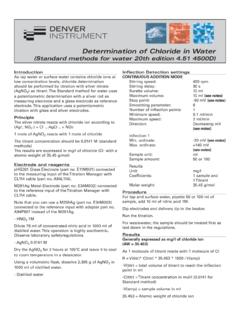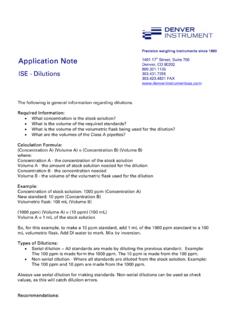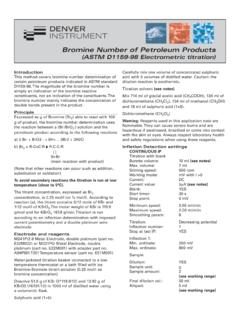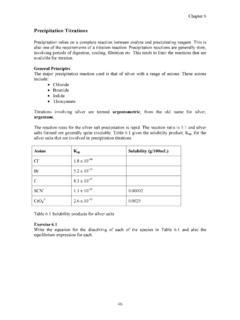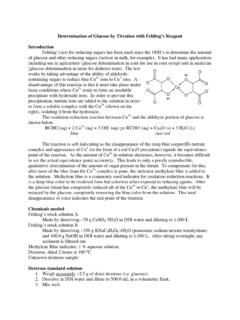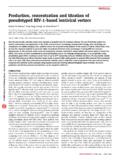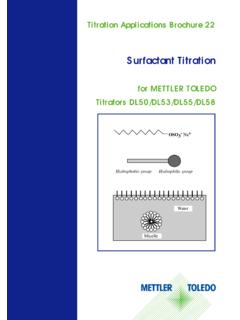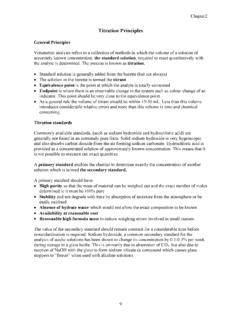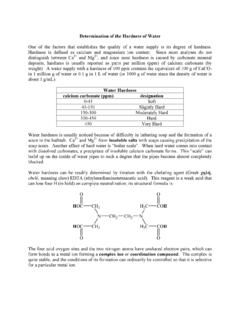Transcription of food and beverage analysis - denver instrument
1 Peroxide Number of Edible Oils (NFT 60-220 (1995) and ISO 3960 (2001)). Introduction Note that the solubility of KI in water is approximately Vitamin C The peroxide number is a measurement of 150g/100 ml of water. the concentration of (-O-O-) groups in edible oils. It is a Do not prepare too a large volume of this solution. measurement of the decomposition of the product and Store it in the dark. in many countries, official standards specify a maximum peroxide number beyond which the oil is Distilled water unfit for human consumption. The peroxide number is Sodium thiosulphate solution (or mol/l) in therefore measured by oil manufacturers during water (Na2S2O3). production and after storage to check its standards use a redox To prepare a mol/l (or mol/l) sodium titration in non-aqueous media,results are generally thiosulphate solution, dissolve g (or g) of expressed in g of peroxide (or active oxygen) Na2S2O3, 5H2O in 500 ml of freshly distilled water (or per gram of product but mmoles/kg or meq of O2/kg freshly boiled and cooled deionised water).
2 Are also used. The following two standards use the same titration principle but not the same solvents. NF T Add 2 or 3 drops of CHCl3 (or g of NaOH), as 60-220 uses chloroform CHCl3 ISO 3960 uses isooctane stabilising agent, and complete to 1000 ml using a C8H18 volumetric flask. According to these two standards,the equivalence Wait for one day and filter the solution if necessary point of the redox titration is determined using starch (precipitation of sulphur can occur). as colour indicator,but it is very easy to use Stock the solution in a brown glass flask. potentiometric determination. From time to time, look at the solution and filter or Summary standardise again if necessary. Peroxide number determination involves a two-step redox reaction: Na2S2O3, 5H2O has a molecular weight corresponding to g/mol.
3 1) Reaction of peroxide group with an excess of iodide ion according to: As solutions with a concentration corresponding to are not very stable, do not store this solution R-O-O-R + 2I- + 2H+ 2 ROH + I2 for more than 1 week. 2) Titration of Iodine with Na2S2O3 solution (generally As Sodium thiosulphate solution is commercially or ) according to: available, you can prepare the or solution I2 + 2S2O32- 2I- + S4O62- by dilution. The titration is run according to inflection detection Check that solvents and reagents do not contain with continuous addition of the titrant with a combined dissolved oxygen. Bubbling nitrogen in the different platinum/reference electrode. solutions is one way to do this. Electrode and reagents Inflection Detection settings MC3051Pt-9 Metal electrode, combined, platinum (part CONTINUOUS IP MODE.
4 With CL114 cable (part no. A94L114). Titration with blank Glacial acetic acid (CH3 COOH) Burette volume: 5 ml Chloroform (CHCl3) (NF T 60-220) (see working Isooctane C8H18 (ISO 3960) range). Max. volume: ml Solvent used for ISO 3960 Stirring speed: 500 rpm Acetic acid/isooctane solution by mixing of 3 volumes Working mode: mV i=0. of glacial acetic acid and 2 volumes of isooctane. Blank: YES. Start timer: 10 s Saturated aqueous solution of potassium iodide (KI). Min. ordinate: 150 mV Add ml of potassium iodide solution and stir for 1. Max. ordinate: 250 mV minute then add 30 ml of distilled water. Stop point: 0 mV. Results Minimum speed: ml/min Expressed as g/g (or mg/kg) of active oxygen the Maximum speed: ml/min results corresponds to: Smoothing parameter: 4.
5 Titration: Decreasing R = Ctitr * Vtitr * 16 * 1000 / 2 * Wsmp potential Ctitr = Titrant concentration in mol/l Inflection number: 1. Inflection 1: Vtitr = Necessary titrant volume in ml 1000 = Constant Min. ordinate: 150 mV to express the result in g Max. ordinate: 280 mV. Stop at last IP: YES 16 = molar weight of oxygen Sample 2 = As 2 moles of titrant correspond to 1 mole of Dilution: NO sample Sample unit: g Wsmp = Weighed amount of sample in g Sample amount: 2. (see working Some other units can be used for result expression. range). Result in mmoles/kg corresponds to: R/16. Results Result 1: Result in meq of active oxygen/kg corresponds to: R/8. Unit: mg/kg Results Reaction: 1 sample + 2 3 determinations on old peanut oil Titrant Mean: mg/kg Molar weight: 16 g/mol (standard deviation: ).
6 (see results). mmoles O2/kg No of equations: 2 (standard deviation: ). Equation 1. Unit: mmoles O2/kg meq O2/kg Formula: R1/16 (standard deviation: ). (blank determination: ml). Equation 2. Unit: meq O2/kg Working Range Formula: R1/8 Use the following table which summarises the data in both standards to determine the necessary amount of Procedure sample: According to NF T 60-220. Peroxide Peroxie Sample Titrant volume Use a stoppered titration vessel. number number amount ml First run a blank titration according the following g/g or mg/g meq/kg (g). procedure but without sample. 0-100 0-12 Then run a titration. 100-150 Accurately weigh the necessary amount of edible oil. 150-250 Add 10 ml of chloroform and stir to dissolve.
7 250-400 Add 15 ml of glacial acetic acid and 1 ml of saturated 400-700 potassium iodide solution. Stop the titration vessel, stir for 1 minute and wait 5 Notes minutes, keeping away from daylight. Procedure The main difficulty is to obtain reproducible results Then add 75 ml of distilled water and titrate with avoiding the influence of atmospheric oxygen. (or mol/l) thiosulphate solution. Note that the saturated solution of potassium iodide is Procedure according to ISO 3960 highly oxidisible. It is necessary to check this solution The general procedure is exactly the same as for NF T using the thiosulphate solution according to 60-220. the procedure described in the standards. Weigh the necessary sample amount.
8 Low values for blanks are recommended (between Dilute with 50 ml of the isooctane/acetic acid solution. and ml according to the standards). After addition of water, the titration medium is a two- phase solution. Check you immerse the measuring electrode in the aqueous phase. Do not use too high a titration speed, because it is necessary to free all the iodine from the solvent layer. Curves

